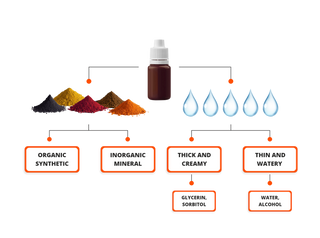

Understanding pigment composition is essential for any PMU artist aiming for long-lasting, vibrant results. Not all pigments are created equal, and each has specific characteristics that affect how they perform on different skin types and undertones. This article dives into the science behind pigments, explaining how organic and inorganic pigments act inside the skin, the role of carriers, and the importance of choosing the right pigments for your clients.
Organic vs. Inorganic Pigments: What’s the Difference?
One of the primary distinctions in pigment composition is whether the pigment is organic or inorganic. Each has its strengths and weaknesses, and understanding the science behind them can help you make informed decisions when selecting pigments for your clients.
- Organic (Hybrid) Pigments: These pigments are carbon-based, and their bright, vivid hues make them a favorite for lip treatments or other areas requiring bold colors. They implant easy in the skin and offer a good retention rate. However, their downside is that they tend to fade and stay in the skin for 2-3 years or longer. Most of the time to clean the pigment from skin, you need removal services such as saline or laser. Also, there is almost no pure organic pigments in PMU, most pigments are hybrid.
Example: BROVI+ Roasted Chestnut is an hybrid pigment that offers rich, warm tones, perfect for creating vibrant results on lighter skin tones. Shop BROVI+ Roasted Chestnut.
- Inorganic Pigments: These pigments are typically made from minerals such as iron oxides. Inorganic pigments provide more muted, natural tones and have greater longevity. They are often the better choice for brows or eyeliner, where subtle color shifts over time are less desirable. Inorganic pigments get naturally removed from the skin by our bodily system in 1.5-2 years.
Example: The Etalon Mix Inorganic Eyebrow Set offers stable, fade-resistant colors, making it ideal for creating natural brow looks. Shop Etalon Mix Inorganic Eyebrow Set.

The Role of Carriers in Pigments
Pigments aren’t just about the colorants. The "vehicle" or carrier is another important component that determines how well the pigment is deposited into the skin and how smoothly it heals. Carriers are responsible for the pigment's consistency and how it flows during the procedure. Common carriers include distilled water, glycerin, witch hazel, and alcohol.
- Glycerin: Known for its thickening properties, glycerin-based carriers allow for more controlled pigment flow, making it easier to deposit pigment evenly. However, they can also cause slower pigment absorption, especially on oily skin.
- Alcohol: Alcohol-based carriers thin out the pigment, making it easier to penetrate the skin quickly. However, they may dry out the skin faster, so they need to be used carefully, particularly with sensitive clients.
Pro Tip: When choosing pigments, aim for a balance between the two carriers to ensure optimal pigment flow and healing. Additionally, selecting the right needle cartridge is crucial for effective pigment delivery.
Example:
The Kwadron Optima PMU Cartridges offer excellent pigment flow, reducing the likelihood of pigment "blowout" while ensuring smooth deposition. Shop Kwadron Optima PMU Cartridges.
Pigment Chemistry and Its Interaction with Skin
When pigments are implanted into the skin, they undergo various biochemical processes that can affect how the color looks over time. This is particularly important for PMU artists to understand, as certain pigments may fade or change color depending on the client’s skin type, undertones, and external factors like sun exposure.
- Iron Oxides: Inorganic pigments, particularly those made from iron oxides, are generally more stable. However, they can sometimes shift towards cooler tones over time, creating a greyish hue, especially on darker skin tones. Using a color corrector in conjunction with iron oxide pigments can help prevent this.
Example: To prevent pigment discoloration, mixing Etalon Mix Orange Corrector with cool-toned pigments helps maintain warmth in the final result, ensuring long-lasting color stability. Shop Etalon Mix Orange Corrector.
- Organic Pigments: While they produce vibrant initial results, organic pigments are more susceptible to fading due to UV exposure and the body’s natural immune response. The immune system gradually breaks down the pigments, leading to faster color changing, especially in areas exposed to the sun.
Customizing Pigments for Different Skin Types
No two clients are the same, and understanding how different pigments work with various skin types is key to creating a personalized experience. Clients with oily skin, for example, tend to have pigments fade faster due to higher sebum production, which can push the pigment out of the skin more quickly.
- Oily Skin: For clients with oily skin, choosing pigments with a thicker consistency or inorganic base helps to ensure longer-lasting results.
- Dry Skin: For clients with dry skin, organic pigments tend to perform better, as they absorb more easily into the skin without becoming overly saturated or "blotchy."

The Future of PMU Pigments: What’s Next?
As technology advances, PMU pigments are becoming safer, more stable, and easier to work with. Recent developments include hypoallergenic pigments for sensitive clients and formulations that are resistant to color shifts. Artists can expect more innovations in pigment chemistry, providing longer-lasting and more predictable results.
Additionally, there is a growing trend towards eco-friendly and ethically sourced pigments. As more clients become conscious of their environmental impact, PMU artists may want to explore pigments that are cruelty-free, vegan, and sustainably produced.
Conclusion: Mastering Pigment Selection for Better Results
Understanding the science behind pigment composition is critical for achieving long-lasting, vibrant, and predictable results in permanent makeup. By selecting the right pigments for each client’s skin type, customizing colors to suit individual undertones, and ensuring a proper understanding of pigment carriers and chemistry, PMU artists can provide the best possible outcomes.
Stay ahead in your field by choosing high-quality pigments from trusted sources, like those available at Supreme Permanent, and continue refining your understanding of how pigments interact with skin to deliver consistent, beautiful results.
